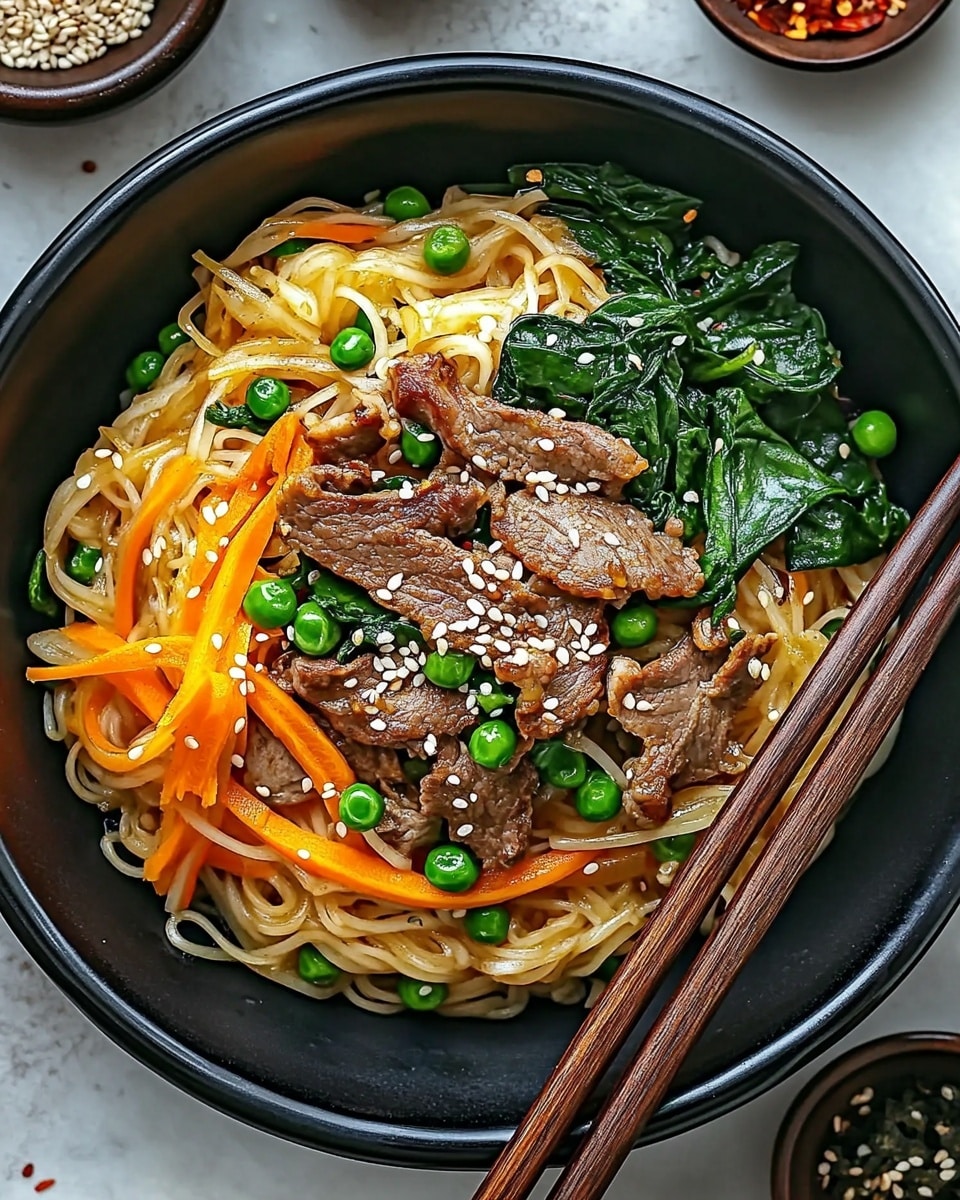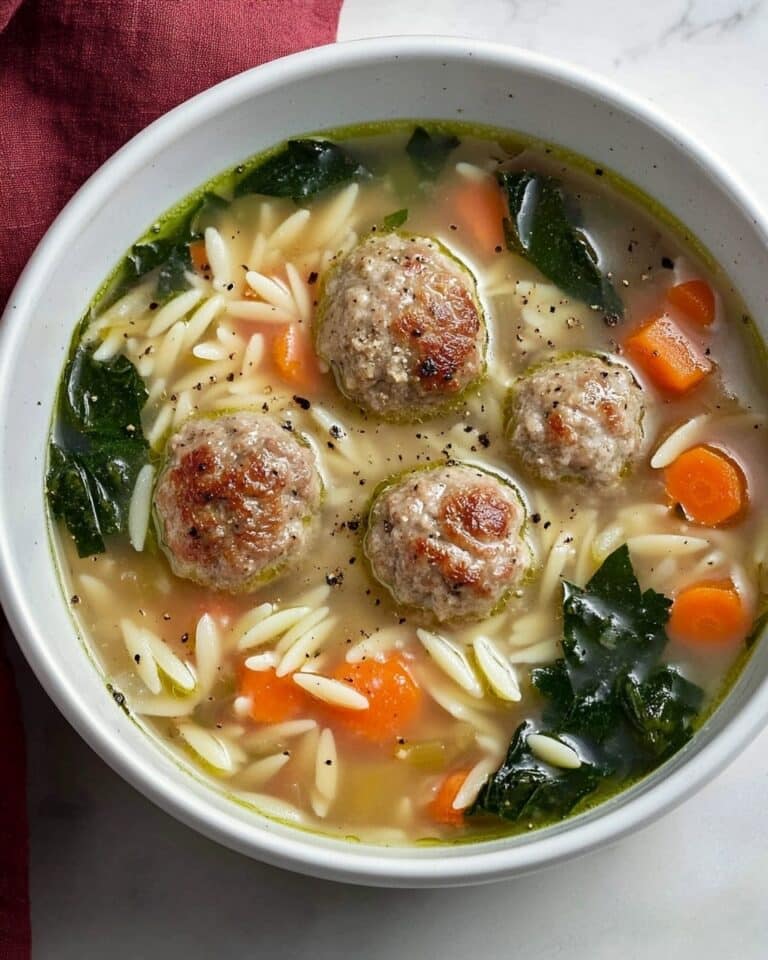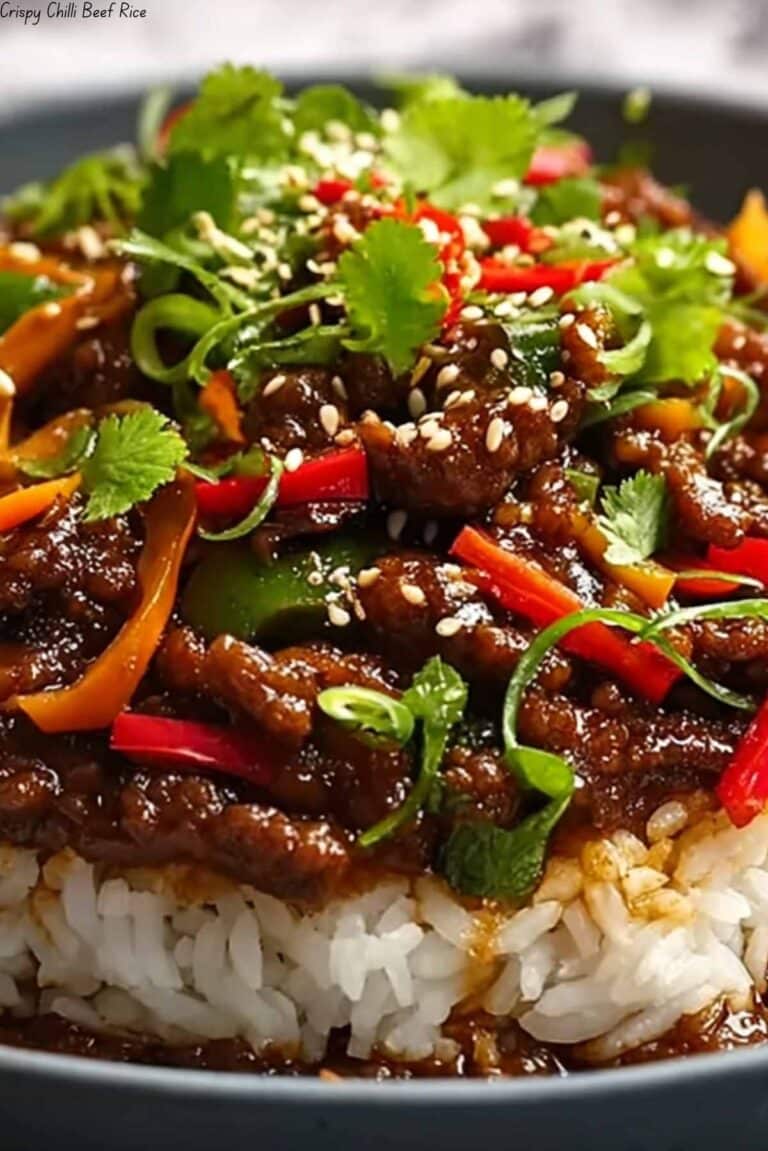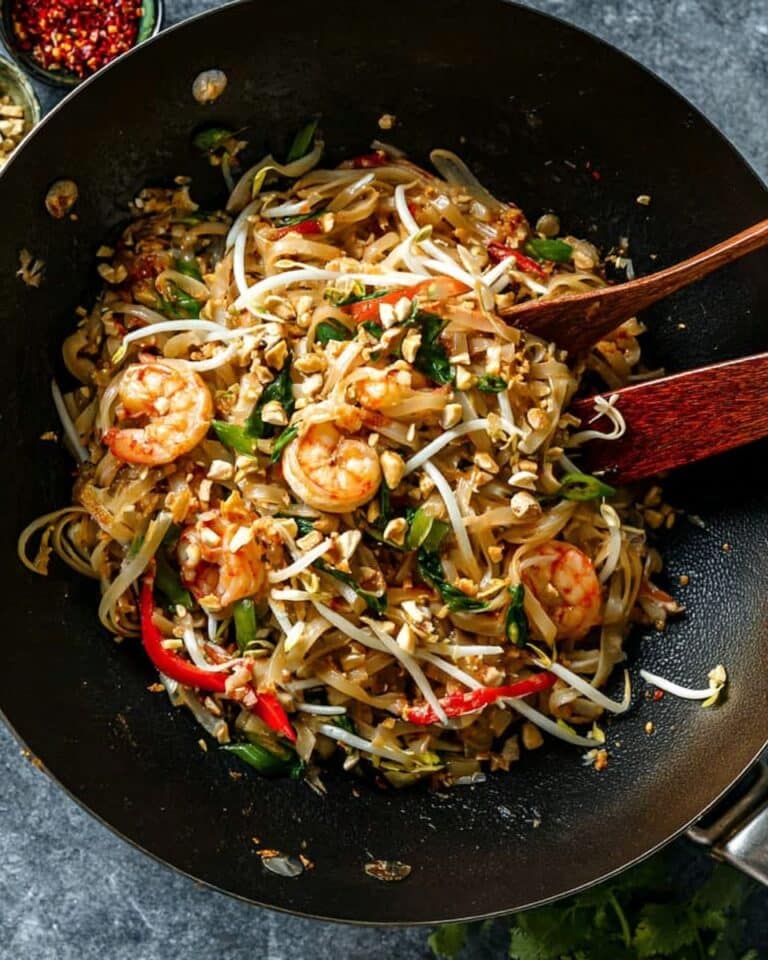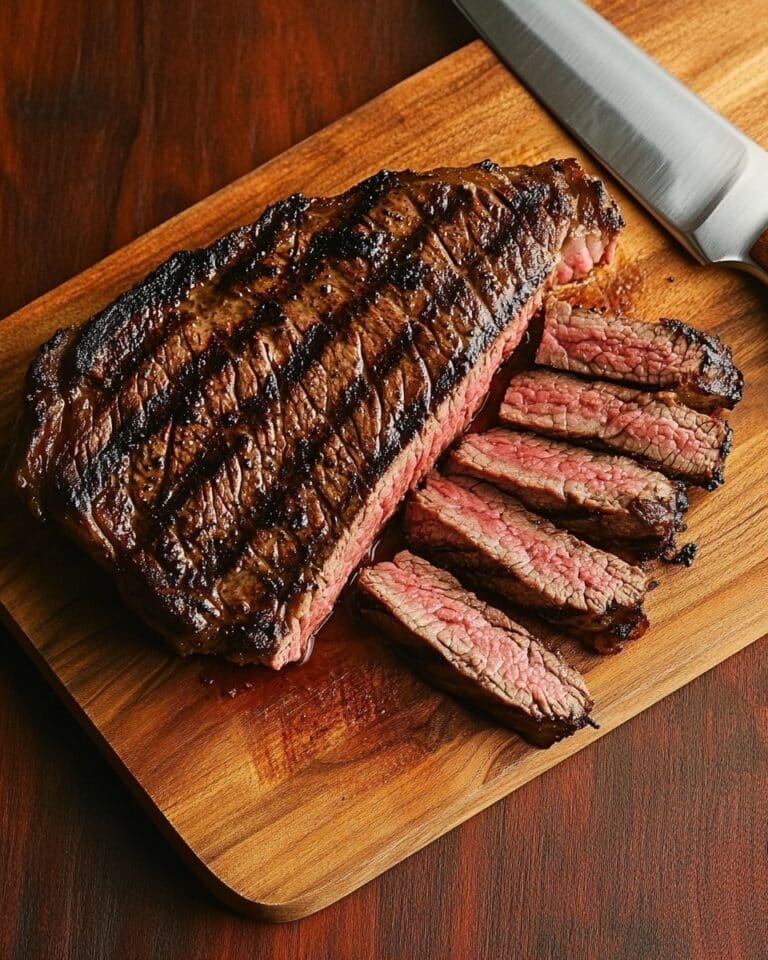Japchae (Korean Sweet Potato Noodles Stir-Fry) Recipe
Japchae (Korean Sweet Potato Noodles Stir-Fry) recipe is one of those dishes that instantly brings comfort and a pop of color to your table. Its chewy, glossy noodles tossed with savory, slightly sweet flavors make it a perfect dish for any occasion—whether you’re hosting a casual dinner or looking for a special weeknight treat. I love it because it’s flavorful, satisfying, and a fantastic way to sneak a bunch of veggies into your meal without feeling heavy.
One of the best things about this Japchae (Korean Sweet Potato Noodles Stir-Fry) recipe is how versatile it is. I’ve made it for potlucks, quick lunches, and even meal prep, and it always steals the show. Plus, once you get the hang of the steps, it comes together pretty quickly. I’ll share some tips here on how to nail it every time, so don’t worry if it’s your first go!
Ingredients You’ll Need
The magic of Japchae lies in its balance of textures and flavors — from the springy sweet potato noodles to the tender beef and fresh veggies. It’s pretty easy to find these ingredients at Asian markets, but a regular grocery store might have most of them too. Just look for good-quality sweet potato noodles and fresh produce for the best results.
- Thin-sliced beef: I usually grab ribeye or sirloin for that great beefy flavor and tenderness; thin slices cook quickly, so keep an eye!
- Korean sweet potato noodles (glass noodles): These noodles are the star — chewy, translucent, and they soak up the sauce beautifully.
- Carrots: Julienned for a bit of crunch and sweetness.
- White onion: Thinly sliced, adding a nice sharpness that balances the sweetness.
- Green onions: Adds freshness and a light onion flavor.
- Garlic cloves: Minced generously to give that essential aroma and depth.
- Spinach leaves: A quick blanch adds earthiness and color without overpowering.
- Sesame oil: Divided between cooking and finishing — this is where the nuttiness in Japchae shines.
- Olive oil: I use this for stir-frying beef for a neutral taste and good sear.
- Soy sauce (or tamari): This provides umami and saltiness; tamari is perfect if you want it gluten-free.
- Brown sugar: Just enough sweetness to balance the savory flavors.
Variations
One of my favorite parts of making Japchae (Korean Sweet Potato Noodles Stir-Fry) is how you can easily tweak it to fit what you have on hand or your diet. Seriously, don’t hesitate to make it your own—it’s forgiving and delicious no matter what.
- Protein swaps: I’ve switched out beef for chicken, tofu, or even shrimp — each gives a fresh twist and still absorbs the sauce nicely.
- Vegan Japchae: Skip the meat entirely, double up the veggies, and boost the umami with mushrooms or a splash of mushroom soy sauce.
- Veggie variations: Feel free to add bell peppers, mushrooms, or zucchini, especially when you want to use what’s in season.
- Spicier version: If you like some heat, toss in a bit of gochujang or red pepper flakes. I do this when I want a kick without overpowering the sweet flavors.
How to Make Japchae (Korean Sweet Potato Noodles Stir-Fry) Recipe
Step 1: Prepare the Noodles and Veggies
Start by soaking the sweet potato noodles in warm water for about 30 minutes until they soften—don’t overdo it, or they can become mushy later. Meanwhile, julienne your carrots, thinly slice the onion, chop green onions, mince the garlic, and give the spinach a quick rinse. Blanch the spinach in boiling water for just about 30 seconds, then dunk it in ice water to keep that bright green color and drain well.
Step 2: Cook the Beef
Heat a tablespoon of olive oil in a large pan and quickly stir-fry the thinly sliced beef until it’s just cooked through—about 2-3 minutes. Don’t overcrowd the pan here; if you have a lot of beef, do it in batches to get a nice sear. Set the beef aside and wipe the pan clean to keep flavors fresh for the next steps.
Step 3: Stir-Fry the Vegetables
In the same pan, add 2 tablespoons of sesame oil and toss in the garlic and onions first—sauté until fragrant and the onions start to get tender. Then add the carrots and cook for another 2-3 minutes so they stay slightly crisp but softened. Add the green onions last and give everything a good stir.
Step 4: Combine Noodles, Beef, and Sauce
Drain the noodles and briefly rinse under cold water to stop cooking, then cut them into easier-to-eat lengths if you like. Add the noodles, cooked beef, and blanched spinach back to the pan with the veggies. Pour in soy sauce, brown sugar, and the remaining 2 tablespoons of sesame oil. Toss everything together gently but thoroughly, letting the noodles soak up all the savory-sweet goodness. Cook for another 2-3 minutes over medium heat, but watch that noodles don’t stick or get mushy.
How to Serve Japchae (Korean Sweet Potato Noodles Stir-Fry) Recipe
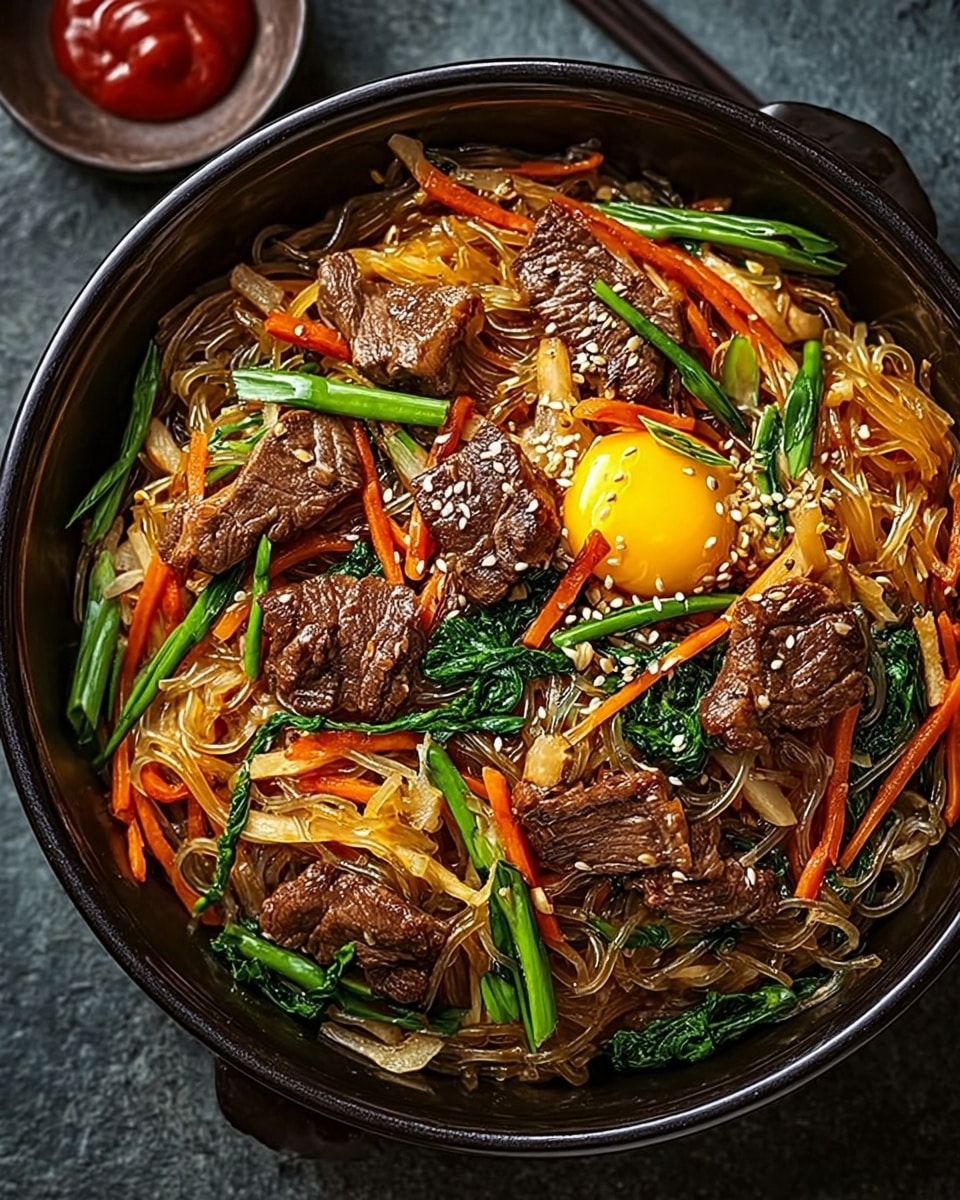
Garnishes
I like to finish my Japchae with a sprinkle of toasted sesame seeds and a few extra chopped green onions for a fresh pop of color and crunch. Sometimes I’ll add a thin slice of toasted seaweed on top — it’s subtle but adds an extra layer of umami that I love. These simple garnishes make the dish look inviting and give it an authentic touch.
Side Dishes
Japchae pairs beautifully with Korean staples like kimchi, steamed rice, or even a bowl of miso soup. When I want to make a full Korean-inspired meal, I’ll throw together some simple pickled cucumbers or a mild soybean paste stew. These sides balance the meal and keep your taste buds excited through every bite.
Creative Ways to Present
If you’re serving Japchae at a party, try arranging the noodles in a shallow bowl and layering colorful veggies on top for a beautiful “noodle salad” look. I’ve even served it wrapped in lettuce leaves for a fun, handheld option that guests love. It’s a great way to present it differently if you want to impress or simply change up your routine.
Make Ahead and Storage
Storing Leftovers
When I have leftovers, I store them in an airtight container in the fridge for up to 3 days. I’ve noticed the noodles absorb more sauce over time, making the flavors even deeper—if anything, it tastes better the next day! Just be sure to keep the container sealed tight to prevent the sesame oil aroma from mingling with other foods.
Freezing
I haven’t had great luck freezing Japchae because the noodles tend to get mushy after thawing. If you want to freeze it, I recommend freezing the beef and vegetables separately from the noodles and then combining them fresh when you’re ready to eat.
Reheating
To reheat, I prefer using a skillet over medium heat with a splash of water or a bit more sesame oil to loosen the noodles. Microwave works too, but the skillet method keeps the texture better and revives that freshly cooked taste. Stir frequently to prevent sticking, and enjoy like it just came off the stove.
FAQs
-
Can I use regular pasta instead of sweet potato noodles in Japchae?
You can substitute with regular spaghetti or glass noodles if you’re in a pinch, but you’ll miss that unique chewy texture and slight aroma that sweet potato noodles bring. If you want a similar effect, try some cellophane noodles made from mung bean or sweet potato starch, which are closest to authentic Japchae.
-
Is Japchae gluten-free?
The sweet potato noodles themselves are naturally gluten-free, but traditional soy sauce contains wheat. Use tamari or a gluten-free soy sauce to keep the dish gluten-free. Just watch labels to be sure, especially with any pre-made ingredients.
-
How long does Japchae take to make?
From start to finish, plan on about 45 minutes—much of that is soaking the noodles and prepping veggies. The actual cooking is pretty quick once everything is ready, usually under 15 minutes.
-
Can I make Japchae ahead of time for a party?
Absolutely! I often make Japchae a few hours ahead of serving. Just let it come to room temperature before serving, or warm it gently in a skillet. The flavors meld nicely when it sits a bit.
-
What makes Japchae unique compared to other stir-fries?
The use of sweet potato noodles gives Japchae its signature chewy texture and glossy appearance that you don’t find in typical stir-fries. Along with the balance of sweet and savory with sesame oil’s nuttiness, it has a distinct flavor and feel that’s both comforting and elegant.
Final Thoughts
Japchae (Korean Sweet Potato Noodles Stir-Fry) recipe holds a special place in my kitchen – it’s that reliable crowd-pleaser that feels a little festive yet is totally approachable. Once you try it, you’ll see why I make it again and again. It’s colorful, packed with flavors and textures, and gives you that satisfying sense of having cooked something homemade and delicious. So go ahead, give it a shot—you’ll love sharing this bright, tasty dish with friends and family just like I do.
PrintJapchae (Korean Sweet Potato Noodles Stir-Fry) Recipe
Japchae is a classic Korean dish featuring sweet potato glass noodles stir-fried with tender thin-sliced beef and a vibrant mix of vegetables like carrots, onions, spinach, and green onions. Flavored with a savory-sweet sauce made from soy sauce, brown sugar, garlic, and toasted sesame oil, this dish is a perfect balance of taste and texture. Japchae can be enjoyed hot or at room temperature, making it a versatile and crowd-pleasing meal or side dish.
- Prep Time: 30 minutes
- Cook Time: 15 minutes
- Total Time: 45 minutes
- Yield: 6–8 servings 1x
- Category: Main Course
- Method: Stovetop
- Cuisine: Korean
Ingredients
Protein
- 2 lb thin-sliced beef (can substitute with chicken, tofu, or shrimp)
Noodles & Vegetables
- 1 lb Korean sweet potato noodles (glass noodles)
- 3 medium carrots, julienned
- 1 large white onion, thinly sliced
- 1/2 bunch green onions, chopped
- 6 garlic cloves, minced
- 1/2 lb spinach leaves
Seasonings & Oils
- 4 tbsp sesame oil (divided)
- 1 tbsp olive oil
- 6 tbsp soy sauce (or tamari for gluten-free option)
- 3 tbsp brown sugar
Instructions
- Prepare the Noodles: Soak the Korean sweet potato noodles in warm water for about 20-30 minutes until they soften. Drain and set aside.
- Cook the Spinach: Blanch the spinach in boiling water for 30 seconds, then drain and squeeze out excess water. Set aside.
- Cook the Beef: In a large pan or skillet, heat 1 tablespoon of olive oil over medium-high heat. Add the thin-sliced beef and half the minced garlic, sauté until the beef is cooked through and lightly browned. Remove from the pan and set aside.
- Cook the Vegetables: In the same pan, add 2 tablespoons of sesame oil. Add the julienned carrots, sliced onions, chopped green onions, and remaining minced garlic. Stir-fry over medium heat until the vegetables are tender but still crisp, about 4-5 minutes.
- Cook the Noodles: Add the softened noodles to the pan with vegetables. Pour in the soy sauce and brown sugar. Toss everything together thoroughly to evenly coat the noodles and vegetables with sauce. Continue stir-frying for about 3-4 minutes until noodles are cooked through and everything is well combined.
- Add Spinach and Beef: Gently mix the cooked spinach and beef back into the pan. Drizzle the remaining 2 tablespoons of sesame oil over the mixture. Toss gently to incorporate all ingredients and flavors evenly. Cook for an additional 1-2 minutes to warm everything through.
- Serve: Transfer the japchae to a serving dish. It can be served warm or at room temperature. Enjoy as a main dish or a flavorful side to your Korean meal.
Notes
- You can substitute beef with chicken, tofu, or shrimp according to your preference.
- For a gluten-free version, use tamari instead of soy sauce.
- Soaking the noodles properly is essential for the correct texture; avoid overcooking.
- Japchae tastes great served warm or room temperature, making it excellent for potlucks or meal prep.
- Adjust the amount of brown sugar depending on your desired sweetness level.
Keywords: Japchae, Korean sweet potato noodles, Korean glass noodles, stir-fry noodle dish, Korean cuisine, beef japchae, vegetable japchae, Korean recipe

